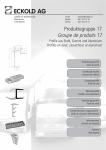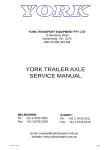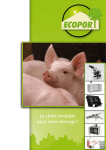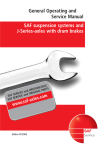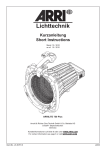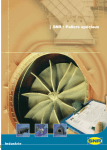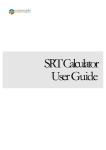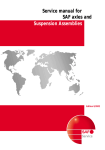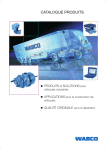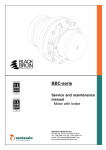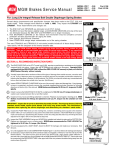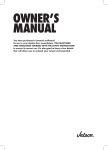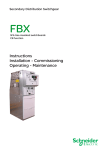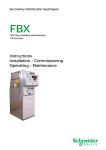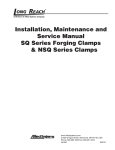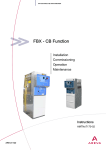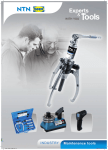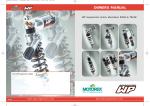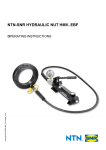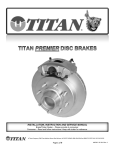Download SAF Main & Repair SK RZ 9019W Disc 2009
Transcript
Maintenance and Repair Manual for SAF Disc Brakes SK RZ 9019 W with WABCO brake calliper Edition 06/2009 Service Vehicle information Manufacturer.............................................................................................................................................................................. Address......................................................................................................................................................................................... Body type..................................................................................................................................................................................... Chassis no.................................................................................................................................................................................... Year of manufacture................................................................................................................................................................. Registration date....................................................................................................................................................................... Spare parts service for SAF axles and suspension systems When ordering spare parts quote correct axle identification serial no., refer to the axle type plate. Please enter the axle identification figures in the type plates shown below so that correct specifications are available when required. Type plate (on the inside of the trailing arm or axle beam) Identification of axles when type plate not available. Production No. of axle on RH side of axle tube. Information Introduction This manual is intended for vehicle operators and workshop service engineers for use with the SAF axles and suspension units. Always read the entire instructions before operating the trailer or proceeding maintenance and repair works. Failure to comply with these instructions without written permission from SAF will void the axle or suspension warranty. The maintenance schedules are recommended by SAF, but as operating conditions and milages dictate frequency in servicing, a maintenance schedule to suit each individual operation must be established by the operator. This manual does not cover all specifications manufactured by SAF. The information contained herein is general in nature. The parts shown in the illustrations are representative, they can vary in some details to your axle/suspension equipment. Every precaution for accuracy has been taken in the preparation of this manual. However, SAF/Transport Specialties Limited do not accept responsibility for any omissions or errors that may appear, neither do they accept legal liability for any loss in connection with the information contained within this manual. Personal Safety Precautions Maintain workshop fitters safety precautions to avoid serious personal injury or loss of life. Only qualified staff are permitted to install, operate, maintain or repair brakes, axles and suspension components. Warning! On all suspensions a system failure may occur, this can cause the trailer chassis or axle to drop violently down. It is recommended that on air suspensions the system is completely deflated during repair works. Before jacking up the axle or the trailer, check for solid ground, chock the wheels. Always firmly secure the chassis and axles on strong support stands. This removes all imposed weight from the suspension and ensures that any work required underneath the trailer is carried out in safety. For the latest SAF information, updates and technical bulletins, visit www.transpecs.co.nz Contents General service instructions for SAF axles and suspension units Vehicle information......................................................................................................................................................................................... 1 Introduction....................................................................................................................................................................................................... 2 General operating instructions................................................................................................................................................................... 4 Service schedule............................................................................................................................................................................................... 5 Service report form.......................................................................................................................................................................................... 6 Maintenance instructions Maintenance instructions for SAF axles SK RZ 9019W – with WABCO Disc Brake type PAN 19-1...................................................................................................................... 7 Bolt / Nut torque values................................................................................................................................................................................. 8 Axle and suspension torque values........................................................................................................................................................... 9 Inspection for brake pad wear...................................................................................................................................................................10 Correct shock absorber fitment ...............................................................................................................................................................10 Brake testing (fault-finding flow chart)...................................................................................................................................................11 Spare part illustration and designation SK RZ 9019W – with WABCO Disc Brake type PAN 19-1............................................................................................................ 12–13 Self adjuster check.........................................................................................................................................................................................14 Special notes....................................................................................................................................................................................................15 Servicing the hub unit.......................................................................................................................................................................... 16–17 Replacement instructions Repairing the brakes............................................................................................................................................................................. 18–20 Repairing the wheel bearings............................................................................................................................................................ 21–23 Installing the hub unit with brake disc........................................................................................................................................... 24–25 Replacing of the tappet rubber boot seals................................................................................................................................... 26–28 Repairing the brake calliper bearing with “guide and seal kit”.............................................................................................. 28–31 Fitting the brake calliper..............................................................................................................................................................................31 Replacing the brake cylinder......................................................................................................................................................................31 Axle alignment................................................................................................................................................................................................32 Service Tools.....................................................................................................................................................................................................33 The item numbers indicated are given only for identification and to distinguish between different versions. Use the part numbers from the valid spare parts documents for identification of spare parts. SAF axles and suspension units are subject to continuous further development; the data and drawings contained in the manual may therefore differ from the details given in the operating permit. The contents of the manual do not constitute the basis for a legal claim. Reprinting, reproduction or translation in whole or in part is not permitted. The issue of this publication invalidates all earlier maintenance and repair manuals. Note: We wish to think WABCO for providing various illustrations! General operating instructions for SAF axles and suspension units 1. Instructions and tips for vehicle operation In order to maintain the operation and road safety of the vehicle, the maintenance operations prescribed by SAF must be carried out regularly at the specified intervals (see “Service instructions”). Furthermore, ensure that 1.1 the disc brake is not overheated due to continuous braking action as irreparable damage to the surrounding components – in particular the wheel bearings – cannot be ruled out. This can impair the operational and road safety of the vehicle and represent a serious hazard for man and machine. 1.2 the compatibility of the brakes on the truck-trailer combination is checked. For reliable braking and uniform brake lining wear, the brake systems of the two vehicles must be matched to each other. 1.3 the parking brake is not applied immediately when the brakes are hot as the resulting different stress fields can damage the brake discs / drums. 1.4 the drum brakes are not overheated as this will result in a dangerous reduction in braking efficiency. 1.5 the maximum permissible axle loads and speeds are not exceeded. 1.6 the cargo is evenly distributed over the loading area and safely secured. 1.7 on vehicles with air suspension, the air bags are always fully inflated before moving the vehicle. 1.8 the prescribed wheel rims and tire sizes are employed. 1.9 The location and securing of the wheels is correctly maintained. Do not repaint the contact faces on either the wheels or hubs. On the contact surface of the wheel the maximum permissible coating thickness of 50 µm (primer plus paint) must not be exceeded. All attachment faces must be clean with plain smooth surfaces free from any contamination of dirt, rust, grease, excessive paint and damage. In general refer to the wheel manufacturers recommendations, or consult your trailer builder for any wheel mounting details. 1.10 the tires are inflated to the prescribed inflation pressure. 1.11 your driving style is matched to the road and weather conditions. 1.12 chassis support legs are used when loading/unloading construction machinery. 1.13 the use of auxiliary trailer braking facilities (trailer underrun brake) is not permitted. 2. Vehicle safety 2.1 The daily check of the vehicle for road safety before moving the vehicle is the responsibility of the driver. 2.2 Modifications to the suspension and braking system are strictly forbidden. 2.3 Compliance with the specified permissible axle loads, observing the specifications in the vehicle operating manual, vehicle inspection intervals and the regular maintenance intervals is the responsibility of the vehicle owner. 2.4 We strongly recommend using only SAF approved replacement and spare parts which are covered by SAF product liability. These products have been thoroughly tested by SAF for safety, functionality and suitability. Usage of these parts guarantees not only safety on the roads but satisfies the legal operational requirements. SAF is not in a position to judge whether those products from other companies represent a safety risk for SAF axles and systems. 3. Warranty Refer to Transpecs Warranty Handbook. 4. Service and spare parts A close-knit service network of SAF partner companies is at your disposal for technical advice on SAF axles and suspension systems as well as for supplying approved SAF spare parts . In case of repair, we strongly recommend using only SAF original parts for those reasons mentioned in point 2.4 SAF axles and suspension units are subject to continuous further development; the data and drawings contained in the manual may therefore differ from the details given in the operating permit. The contents of this manual does not constitute a basis for a legal claim. Reprinting, reproduction or translation in whole or in part of this manual is not permitted. This manual supersedes all earlier maintenance and repair manuals. Service schedule SAF Service Schedule - SKRS/RZ 9019W These are minimum requirements, operators must implement a service schedule to suit their specific requirements Service Schedule Mileage intervals > After First 5,000km or Time intervals > Whichever occurs first Periodic check every 30000 km every 120000 km after first month every 3 months every 12 months • • Comments / Mechanical check Attention: Torque check wheel nuts after the first 50 km and 150 km (repeat after every wheel removal). Follow a prescribed wheel nut torque procedure. Torque check all nuts and bolts to recommended setting Intra/Modul Shock absorber bolts 400Nm Intra/Modul Pivot bolts 1200Nm All axles Wheel nuts 600Nm All axles Hub nut 900Nm Intra Air spring mounting nuts Modular Air spring screws Plastic base 20Nm Steel base 80Nm Plastic base 20Nm Steel base 80Nm Modular U Bolts 580Nm Modular Air spring mounting plate 180Nm Check wheel bearings for noise and play. Hub end-float adjustment not possible, carry out hub service checks if required. Max axial play 2.5mm • • • • • • • • • • • • • • • • • • • Minimum Requirement Pack wheel bearings with fresh grease after 500,000 km or 48 months, whichever comes first. Check condition of taper roller bearings and replace if necessary. Remove hubcaps and check for lubricant leakage. Check brake caliper for adjustment, remove pads and ensure slides are free. Clean out dust and inspect all boots for holes. Remove hub from spindle and add anti seize compound. Check Truck and Trailer Compatability (Brake Balance) Max Lead 0.14bar Visual and safety inspection Components found to be worn down to their wear limits must be renewed Inspect the brake caliper guide system. Check for free movement and sliding action. Brake caliper, inspect rubber boots for cracks and damage. Check adjuster cap for correct seating. Inspect the brake pad thickness at regular intervals (e.g. whenever tyre pressure is checked) but at least every 3 months. Inspect the brake disc for cracks. Inspect suspension components for correct fastener connections, wear, leakage, corrosion, distortion, damage. Check hanger brackets, inspect the pivot bolts and shock absorber bolts with recommended torque setting. Inspect suspension for correct ride height setting, readjust if required. General inspection Check brake efficiency and application. Check air springs for damage or cracks. Ensure all ABS sensors fitted are aligned and cabling is in good condition. Check for air leaks. All air line connections are in good condition . All piping is secured and no signs of chaffing. Brake chamber blanking grommets are removed from the correct locations. Shock absorbers fitted correctly. • • • • • • • • • • • • • • • • • • • • • • • • • • • • • • • • • • Every Reline Torque specifications:Refer SAF General Operating and Service Manual or visit www.transpecs.co.nz, choose technical to download PDF file. Special service conditions Vehicles with Aluminium Hangers or Steer Axles please refer to separate service instructions on these items Vehicles with long standing periods: service at specified time intervals Vehicles used under extreme conditions: shorten the service interval by 1/2 e.g. Forestry, construction site operation, multi-shift operation, offroad, regular river fording, construction site & multi shift operations. Warranty claims will only be accepted as long as the operating and maintenance instructions have been complied with and only genuine SAF replacement spare parts have been used 5 Service Report Complaint*: - Customer / Contact Person* -- Report No. Tel:* -- W Transpecs Customer No Customer Order Number* --- Date* - / Vehicle Manufacturer* - Registration No*. -- Chassis No*. Date of Registration* Mileage* -- SAF axle type* -Disc / Drum*-Ride Height Suspension type* INTRADISC / Modular / Mechanical / Other st Serial No. 1 Axle* -Serial No. 3 nd Serial No. 2 nd - /2 Axle -- th Axle -- Serial No. 4 Axle -- Garage/Repairer* -Contact: -- Date of Repair Invoice No. -- Tel*: --- Tick approprite box*: Vehicle type Position on vehicle Body type Left Right Front “B” Other Rear B LSV Yes / No 1 st Axle Tipper Tanker EBS: Yes / No 2 nd Axle Stock Low Loader ABS: Yes / No 3 nd Axle Flatdeck 4 th Axle Container Tractor Manufacturer: Type: --Registration date: Km: -Loaded Truck and Trailer compatibility completed: Yes Date: Carried out by (W/Shop): -Date: Kms: -Trailer Last Service Carried out by (W/Shop): - Curtainsider Tyre Size: x Single / Dual EBS No Yes No Copy invoice encl: Yes / No KMS -- -Copy invoice encl: Yes / No Important: Stage One: All items/boxes marked * must be completed in full and returned to Transpecs before any replacement parts can be dispatched. Stage Two: Labour invoices with a completed copy of this Report, to be returned to Transpecs within 5 days of the date of repair. Stage Three All replacement parts subject to this claim required by Transpecs must be returned to within 14 days. Failure to submit all the required information and parts will result in an invoice being raised to cover costs of replacement parts, labour, transportation and/or any other costs involved. Fax Back To Transpecs 09-980-7348* 6 Return Completed form to Transpecs with invoices when repairs are completed Maintenance instructions SK RZ 9019 W with WABCO Disc Brake type PAN 19-1 Hub unit inspection Grease for repairs is contained in every repair kit. 48 of taper roller bearing and replace if necessary. Do not dismantle the hub bearing assembly, unless carrying out a regreasing. Inspect the Hub Unit at any brake disc replacement. Check for excessive grease leakage and any abnormal noises whilst rotating the hub. When replacing brake pads inspect the rubber boot seals of the calliper guide pins and the tappet seals. Stub axle: 5 387 0015 06 5 387 0021 01 600g 1kg or Hub Unit. Tighten Hub Nut 900 Nm On left-hand side in direction of travel: Left-hand thread On right-hand side in direction of travel: Right-hand thread Tightening torque to 900 Nm. Each hub unit must be rotated smoothly at least twice while tightening the nut. Marking of the nuts with left-hand thread: Milled groove on outside of hexagon. NOTE! Worn brake linings or excessively worn brake discs result in a reduction in Maximum wear limits Brake Rotor Brake Pad Diameter (mm) „A” new (mm) „B” max. wear limit (mm) „C” new (mm) „E” max. wear limit (mm) 370 45 37 30 11 Brake pads, use only original SAF spare parts for replacement. Tightening torque in Nm Bolt assembly’s Attention! Bolts must not be oiled! Pos.-No. Brake chamber / spring brake chamber 2 hex. nuts M16x1.5 Guide pin bolts on brake calliper Brake calliper mounting on axle M16x1.5x55 Pad retainer clamp Assembly tools Hub nut socket Hub puller Lever for hub cap Tool box WABCO SK RZ 9019 W 210 70 80 56 56.1 63.1 63.2 340 ± 20 290 30 ± 15 SAF Part No. 1 012 0024 00 4 434 3822 00 1 434 1041 00 3 434 3328 00 7 Bolt / Nut torque values The following tightening torques are only valid if no other values are given in the axle maintenance chart. Torque wrenches settings, impact wrench not permissible. Thread M8 W.A.F. 13 M8×1 M 10 W.A.F. 17 / 16 M 10 × 1 M 12 W.A.F. 19 / 18 M 12 × 15 M 14 W.A.F. 22 / 21 M 14 × 1.5 M 16 W.A.F. 24 M 16 × 1.5 M 18 W.A.F. 27 M 18 × 1.5 M 20 W.A.F. 30 M 20 x 1.5 M 22 W.A.F. 32 M 22 × 1.5 M 24 W.A.F. 36 M 24 × 2 M 27 W.A.F. 41 M 27 × 2 M 30 W.A.F. 46 M 30 × 2 M 36 × 2 W.A.F. 55 Wheel fixing: Wheels see appropriate axle maintenance chart. Material 8.8 10.9 12.9 25 35 41 27 38 45 49 69 83 52 73 88 86 120 145 90 125 150 135 190 230 150 210 250 210 300 355 225 315 380 300 405 485 325 460 550 410 580 690 460 640 770 550 780 930 610 860 1050 710 1000 1200 780 1100 1300 1050 1500 1800 1150 1600 1950 1450 2000 2400 1600 2250 2700 2450 3450 4150 Axle & Suspension Torque Values Axle SK RS / RZ 9019 Hub Nut L/H side direction of travel - L/H thread - Grooved hub nut and Spindle R/H side direction of travel - R/H thread - Axle serial number on spindle 200 Nm + 15 Deg In service hub not torque check whilst rotating the hub twice 900 Nm Brake Caliper mounting bolt M16 290 Nm Guide/Slide Pin bolts M16 290 Nm Wheel Nuts M22 600 Nm Modular Suspension Pivot Clamping Bolt Assy M30 Pretighten to 400 Nm + Final tightening torque 400 Nm + 120º Shock Absorber Nuts M24 400 Nm U/Bolts for Trailing Arms M22 (Diagonally in three Stages) 650 Nm Air Spring Mounting Plate M20 180 Nm Air Spring Upper Nut M12 40 Nm Air Spring Self Tapping Bolt (Plastic Plunger Piston) 20 Nm Air Spring Bolt (Steel Plunger Piston) 80 Nm lntradisc Dual Pivot Clamping Bolt Assy M30 Pretighten to 400 Nm 400 Nm Final tightening torque 120º In service checking torque Shock Absorber Nuts M20 1200 Nm Nut Contact Surface Dry 600 Nm Aluminium Hanger Brackets Pivot eye bolt Inspection torque 1200 Nm Shock absorber bolt Inspection torque 600 Nm Air Spring Top Nut M12 Air Spring Plunger Bolts M16 40 Nm Plastic Plunger Piston Steel Plunger Piston 80 Nm 180 Nm 9 Maintenance (Visual inspection for brake pad wear) SK RZ 9019 W with WABCO Disc Brake type PAN 19-1 Check brake pads for wear Wear limit Long guide pin > 97 mm Short guide pin > 70 mm shockabsorber fitment.pdf 08/04/2006 13:49:53 shockabsorber fitment.pdf 08/04/2006 13:49:53 Check wear limit of brake pads and brake disc replace if necessary. When distance on long guide pin is exceeding 97 mm or on short guide pin exceeding 70 mm. 90 Correct Shock Absorber Fitment Bolt Kit 78 / crossmember Steel hanger bracket 90 3 341 2803 10 78 Collared bolt M20×1.5×120 -10.9 4 343 2803 10 - dacromet coatedCollared nut M20×1.5 - 10 4 247 4044 10 Tightening torque: Contact surfaces greased: 500Nm Contact surfaces dry: 600Nm C M Y C CM M MY Y CY Attention: TOP mark facing upwards in working position CM CMY n itio MY K CY Bolt Kit 3 341 2802 10 CMY Collared nut M20×1.5 - 10 4 247 4044 10 Tightening torque: Contact surfaces greased: 500Nm Contact surfaces dry: 600Nm 10 P TO s Po TOP K Collared bolt M20×1.5×150 -10.9 4 343 2802 10 - dacromet coated- Axle Centre Wheel side Wheel side TOP 68 68 Functional suspension arm Axle Centre brake testing fault finding procPage 1 25/06/2006 15:06:29 Maintenance instructions Brake test Fault-finding chart Disc brake Lift vehicle, turn wheel by hand Does wheel turn freely? NO Residual pressure in brake cylinder? NO C YES Running clearence OK? YES NO YES M Check upline brake devices and replace, if necessary Running clearence OK? Y CM NO YES MY END Check adjuster END Uneven brake pad wear? 1) NO YES END CY CMY Check brake calliper bushings and repair, if necessary Adjuster OK? K NO YES END Brake calliper guide system OK? NO YES Binding not due to disc brake Replace brake calliper END END Check brake calliper bearings and repair, if necessary END 1) Difference between wear of inboard and outboard pad, and diagonal wear ≤ 5 mm. 11 SV11368MS SK RS/RZ 9019W Axle - (Wabco Caliper) 12 SK RS/RZ 9019W Axle - (Wabco Caliper) Item 19 20 22 22.1 27 27 27.2 27.3 29 29 29 31 34 34 38 38.1 39 40 40 41 56 56.1 59 60 64 70 76 76.2 78 Part Number 4 315 0052 00 4 315 0056 00 1 011 0070 00 1 011 0071 00 3 307 3026 00 3 307 3033 00 3 434 3012 00 5 387 0011 05 4 079 0004 00 4 079 0014 00 4 079 0012 00 1 303 1075 11 1 303 1112 10 1 095 1057 00 1 303 1125 10 24738/ISO B5781/32 4 373 0043 01 4 373 0044 01 3 434 3014 01 4 315 0054 00 3 304 0092 00 3 304 0092 20 1 094 0037 00 4 337 2026 00 4 343 2914 10 4 375 1004 10 3 080 0032 00 3 080 0033 00 3 057 0080 00 3 434 3827 01 4 189 0051 00 4 343 2067 00 4 029 1042 00 Qty 2 2 1 1 2 2 2 2 2 2 2 16/20 16/20 16/20 16/20 16/20 16/20 2 2 2 2 2 2 1 2 10 2 1 1 1 2 2 4 2 PWI 1 012 0024 00 4 434 3822 00 3/434/3328/00 5/387/0021/01 3/434/3327/00 1 1 1 1 1 1 Description Axle Nut Lock Oring Axle Spindle Oring R/H Axle Nut M120x2/SW140 L/H Axle Nut M120x2/SW140 Hub and Bearing Assy Dual Alloy Wheels Hub and Bearing Assy Dual Alloy Wheels Bearing and Seal Kit Hub Grease Pack Disc Brake Rotor 22mm Hole Disc Brake Rotor 27mm Hole Disc Brake Rotor Wheel Bolt Wheel Bolt 112mm Wheel Bolt Spacer (used with 1 303 1112 10 stud) Wheel Bolt 112mm (stepped shoulder) Wheel Nut Wheel Nut Dual Alloy (Sleeved) Inner Hub Seal Outer hub Seal Hub Seal Kit Hub Cap Oring Hub Cap Chrome Hub Cap Hubo Mount Washer Protection Plug Caliper Mount Bolt M16 Caliper Mount Bolt R/H WABCO Brake Caliper L/H WABCO Brake Caliper Brake Pad Set Tappet and Guide Pin kit ABS Sensor Mount Bracket ABS Sensor Mount Screw ABS Sensor Notes / Alt no. 8 stud 275PCD 10 stud 285PCD Sleeved nut - 8 stud 275PCD 8 stud 275PCD 10 stud 285PCD (20, 27.3, 38, 38.1) PAN19-1RH PAN19-1LH 12/999/737 12/999/738 (65,66,70,80) 441 032 579 0 Tools Pad Wear Indicator Hub Nut Socket Wheel and Hub Puller Wabco Caliper Tool Kit SAF Fitting Paste - 1kg Tube SAF Calliper Adjuster Tool 13 Maintenance instructions Self-Adjuster check Remove adjusting screw cap. Caution! Do not overload or damage the hexagon drive (8 mm) of the adjusting screw. Do not use an open-ended spanner. Turn the adjusting screw clockwise using an 8 mm ring spanner. Actuate the brakes 5 times (approx. 1 bar) When the self-adjuster is functioning correctly the ring spanner must turn anti-clockwise. Caution! Ensure that there is sufficient room for the ring spanner to rotate freely during adjustment. Keep your hands off from the spanner whilst actuating the brakes. Danger for serious personal injury. Note: As the number of rotation steps of the ring spanner increases, the turn angle or movement of the ring spanner must reduce. If the spanner rotates as described above, the self-adjuster is functioning correctly. If the following faults occur: The adjusting screw or ring spanner a) does not turn, b) turns only with the first application of the brakes, c) turns forward and then back again at each application of the brakes, the self-adjuster is not functioning correctly and the brake calliper has to be replaced. Remove the ring spanner. Coat the adjusting screw cap with grease in the snap-fit area, then push on the cap and ensure that it is firmely seal tight fitted. Inspect condition of adjusting screw cap for proper seal function to avoid water entry into the self-adjusting gear. Replace adjusting screw cap if found worn or damaged. 14 Maintenance instructions Special notes BRAKE BALANCE To obtain maximum performance from the disc-brakes, brake balance between the truck and trailer must be carried out before going into service and again at 5000km service, and then every 12 months thereafter. Maximum lead to trailer must not exceed 0.14 bar (2 psi). Ensure that brake chamber plugs are removed from the bottom most drain holes. Brake calipers are not covered by warranty for ingress of water or corrosion. INSTALLATION REQUIREMENTS FOR WARRANTY VALIDATION AND MAXIMUM CORROSION RESISTANCE, PLUG TOP & SIDE HOLES ONLY! REMOVE PLUG FROM BOTTOM MOST DRAIN VENT HOLES installation requirements label.1 1 08/10/2006 15:29:22 Only brake cylinders approved by the brake or axle manufacturer may by used. Ensure the drainage holes are correctly located. Painting instructions During painting work, all rubber parts must be covered as otherwise the rubber will become brittle and thus be damaged. 15 lour.pdf 07/05/2006 Service of the Hub Unit 11:55:41 We recommend that you carry out the wheel rock test and wheel bearing noise test and check the function of the seal system (grease leakage) in the event of signs of a malfunction. At brake disc changes and in the event of damage, e.g. brake overheating, inspect the bearing for grease leakage. For further instructions, refer to the error flow chart. Wheel rock test Pull Press 1. Raise the wheel. Do not remove the wheel! Dial gauge 2. Carefully remove the wheel cap. 3. Check the prescribed tightening torque of the axle nut (900 Nm). 4. Position the magnetic foot of the dial gauge as shown on the left. 5. By alternately pulling and pressing (first pull at the top and press at the bottom, then pull at the bottom and press at the top), rock the wheel and read off the travel on the dial gauge. Rotate the wheel several times before each measurement! Note! If a wheel rock of more than 0.25 mm (250 µm) is measured, the hub unit has to be serviced. Press Pull Example illustration “OK” Grease leak test Increased grease leakage 1. Indicator: If the wheel flange is covered with grease up to half the height when “dry”. 2. Carefully remove the wheel cap. 3. If the complete inside of the wheel flange, i.e. inside of cover, axle nut, axle tube and seal are covered with grease, an increased grease leakage has occurred. Example illustration “Not OK” Note! There may be a small amount of grease on the lower edge of the seal. This is normal and does not indicate grease leakage. Seal not completely covered. Normal operating condition (= after a prolonged period of operation). Hub unit is OK. Seal completely covered all over with tar-like grease. Recommended measure: Service the hub unit 16 Example illustration rature guPage 1 Service of the Hub Unit Wheel bearing noise test Turn the wheel backwards and forwards 26/06/2006 20:18:46 (fast and slow) 1. Raise the wheel. Do not remove the wheel! 2. Carefully remove the wheel cap. 3. Check the prescribed tightening torque of the axle nut (900 Nm). 4. Turn the wheel in both directions (fast and slow). 5. If the bearing feels rough and / or a “grinding” noise is heard, the hub unit has to be serviced. Note! Noises can also be caused by the brakes. Before removing the hub unit, remove the brake pads and repeat the bearing noise test. Note! Measure the wheel rock. Wheel rock up to 0.25 mm is admissible. Annealing colours on the flange Annealing temperature ºC Pale yellow 200 Straw yellow 220 Golden yellow 230 Yellowish brown 240 Terra-cotta 250 Red 260 Purple 270 Violet 280 Dark blue 290 The discolouration is to be seen at the contact points to the brake disc and at the chamfer to the centring diameter or at the bottom of the blind holes (see figures). This discolouration is blue, red or occasionally tending to yellow. Discolouration in this area can be caused by incorrect function/ operation of the brakes. The brake system must therefore be checked for tractor/trailer brake synchronisation and for adaption. It must be assumed that particularly the grease or the bearing race and the seal have been subjected to thermal damage. If large amounts of grease escape at the same time from the outer seal (under the cap), the hub unit must be serviced. “OK” “Not OK” Cornflower blue Pale blue 320 Bluish grey 340 Grey “Not OK” 300 360 Recommended measure: Replace the hub unit. 17 Replacement instructions Repairing the brakes Removal of the brake calliper. Park the vehicle on level, solid ground and chock the wheels to prevent the vehicle from rolling away. Lift the axle using a jack. Loosen the wheel nuts and remove the wheel. Remove the adjusting screw cap. Turn the adjuster in anticlockwise direction up to the stop until it clicks 2–3 times. Unbolt the diaphragm cylinder, if necessary. Remove the pad retaining clamp. Remove the brake pads. Unbolt the brake calliper. Lever the hub cap off the hub unit by inserting a tyre lever into one of the recesses around the circumference of the hub cap. 18 Replacement instructions Press the ABS sensor completely out of the sensor mounting block and place inside the axle tube. The sensor holder can remain on the axle nut. Loosen the axle nut and unscrew from the stub axle. Axle nut wrench: SAF Part No. 1 012 0024 00. Note: Axle nut: W.A.F. 140 On left-hand side of vehicle (as seen in direction of forward travel) – left-hand thread. Identification of axle nut with left-hand thread: Milled groove on outside of hexagonal head. The complete hub unit with brake disc can be easily pulled off the stub axle. If the bearing inner races tilt on the stub shaft, the hub unit can be pulled off using a normal workshop puller or SAF Part No. 4 434 3822 00. Note: Do not disassemble the hub unit bearing assembly! The wheel bearings have a long-life grease packing. Grease change intervals, see chapter “Maintenance instructions”. Adjustment screw Pressure plate Check the brake calliper for free movement, and sliding action. Back off the tappets on the adjuster until the boots are visible. Perform a visual inspection of the boots and all seals. Screw in the tappets again completely. 19 Replacement instructions Brake disc See table in chapter “Maintenance instructions”. The brake disc may only be cleaned using a dry cleaning agent. A1 Inspecting the brake disc B1 Inspect the braking surface of the brake disc carefully for serviceability. A1 – Network-like cracks are permissible. B1 – Cracks up to max. 1.5 mm (width and depth) running towards the middle of the hub are permissible. C1 – Unevenness in the disc surface up to 1.5 mm is permissible. D1 C1 D1 – Cracks going right through the disc are not permissible. Check the brake disc thickness and machine, if necessary. For safety reasons, the limit thickness for machining the brake discs is 39–40 mm. Max. wear limit, see table in chapter “Maintenance instructions”. Replacing the brake disc To remove the brake disc from the hub unit, drive all the wheel bolts out of the hub unit using a hammer. Removal of the circlips is not necessary. Before reassembling wheel hub and brake disc, remove any corrosion from the contact surfaces. Insert the wheel bolts at an angle from below and hammer into place (observe twist lock). Draw the bolts completely into the hub unit using a wheel nut and an impact wrench. 20 Replacement instructions Repairing the wheel bearings Changing the wheel bearing grease As the operations are identical for both procedures, the descriptions are contained in the same chapter. Arrangement of wheel bearing assembly with seals After 500,000 km or after 48 months’ operation, the following 3 procedures are possible: Wheel bearing kit 1) Inspection of the wheel bearing for further serviceability with grease change and replacement of the seal rings. 2) Replacement of the complete wheel bearing assembly with seals and long-life grease. The wheel hub can continue to be used. 3) Installation of a complete original compact wheel hub. The wheel bearing has to be disassembled for the inspections; replace any parts which are worn or damaged. The wheel bearings must be in a good and serviceable condition. The outer races must still have a correct, secure seating in the wheel hub. The wheel bearing must turn freely without noises. During assembly of the wheel bearing set, ensure absolute cleanliness of life of the wheel bearings. Note: Replacement of only one bearing is not permitted. Always change the wheel bearings in pairs with the complete seal set and the prescribed grease packing. Original compact hub The wheel bearing axial clearance must not exceed 0.25 mm. If the permissible limit for the wheel bearing clearance of 0.25 mm is exceeded, the wheel bearing set or optionally, the bearing hub must be replaced. Checking of the axial clearance should be expediently carried out when changing the brake disc. 21 Replacement instructions Removing the wheel bearing assembly Lever out the retaining ring using a screwdriver. Place a drift against the joint of the two wheel bearings and drive the bearing inner races out of the wheel hub together with the seal rings. Drive the bearing outer races out of the hub housing using a normal workshop drift. Thoroughly clean the hub housing. Installing the wheel bearing assembly Drive both bearing outer races into the hub housing until they bottom. Use installation tool, SAF Part No. 3 434 1043 00. Pack the space between the bearing outer race and shoulder with long-life grease. Coat the taper roller bearing with the remaining grease. Distribute the grease supplied in the repair kit uniformly over both bearings and use up completely. 22 Replacement instructions Place the bearing inner races into the hub. Secure both bearing inner races with the retaining ring. Pack the ring gap on the face side of the bearing with long-life grease. Fit the seal rings. Press the seal rings into the hub on both sides using the installation tool, SAF Part No. 3 434 1043 00, until they are flush with the edge of the hub. If the hubs are subsequently painted, ensure that the contact surface for the wheel is not painted. 23 Replacement instructions Installing the Hub Unit with brake disc Completely coat the wheel bearing seats on the stub shaft and in the Hub Unit with SAF fitting paste (SAF Part No. 5 387 0015 06). See chapter “Maintenance instructions” for recommended media. Replace the rear O-ring on the stub shaft. Inspect the O-ring on the axle nut and replace, if necessary. 900 Nm Push the Hub Unit brake disc assembly onto the stub axle. Screw on the axle nut. Axle nut W.A.F. 140: On LH side of vehicle (as seen in direction of forward travel) – LH thread. Identification of axle nut with LH thread: Milled groove on outside of hexagonal head. Tighten the axle nut. Axle nut wrench: SAF Part No. 1 012 0024 00 Pre-tighten the axle nut to 900Nm whilst rotating the hub at least twice. Loosen the axle nut again and repeat procedure. Completely coat the ABS sensor with copper paste and install in the sensor holder. Inspect the O-ring on the Hub Unit for the snap fastening of the hub cap; replace, if necessary. Push on the hub cap and check that it is securely seated. Remove the plug from the hub cap and push the ABS sensor until it is contacting the exciter ring. Insert the plug into the hub cap again. Measure the voltage output on the ABS sensor cable using a voltmeter (approx. 100mV) whilst rotating the hub. 24 Replacement instructions Pressure plate Adjustment screw Move the brake calliper so far so that there is enough distance between the brake disc on the actuation side to insert the brake lining. Insert the pressure plate into the brake mounting and push it against the adjustment screw. Note! The pressure plate must seat correctly in the brake mounting guide and the pin of the adjustment screw must be seated in the groove of the pressure plate, otherwise the correct functioning of the adjustment mechanism is endangered! Provision is made so that the adjustment screw can be turned until the pin sits correctly in the pressure plate groove. The protection cap must not be rotated during this action. 64.1 Inserting new brake linings 64.1 on the actuation pad. Move the brake calliper in the direction of the rim until the actuation side of the brake lining 64.1 sits on the brake disc. 64.1 Inserting new brake linings 64.1 on the rim side. With the help of a 1 mm thick feeler gauge (arrow) inserted between the rim side of the lining and the brake calliper, regulate the adjuster with a ring spanner until both brake linings sit on the brake disc. Attention! Do not use excessive force on the corners of the adjuster. Note! Direction of rotation in regulating the adjuster is anti-clockwise. Do not assemble the lining retainer hoop until play has been adjusted. 64.2/64.1 63.1 Setting new retainer springs 64.2 onto the brake linings 64.1 and pressure plate. Push and depress the lining retainer hoop 63.1 in the opening of the brake calliper so that the radial lugs of the retainer spring seat in the hoop. 25 Replacement instructions Affixing new hex. screw 63.2 with 30±15 using a spanner onto the brake calliper. 63.2 Push the new plug 65 into the opening of the brake calliper! Check the wheel hub for freedom of movement. Note! Check the brakes on a rolling road test station after completion of work. 65 Replacing of the tappet rubber boot seals Dismantle brake linings and pressure plate. Move brake calliper by hand towards the cylinder. Pull out the protection cap 66 using a screwdriver from the brake calliper seating. Check the thread on the adjuster screw. Note! Lay the rim side brake lining in the lining cavity so that the adjuster cannot be screwed out of adjustment. After checking remove the linings again. Secure the adjuster screw against turning (arrow) and screw out approx. 30mm anti-clockwise using a ring spanner on the hexagonals. During this time check the thread for damage or corrosion. 26 Replacement instructions 66 Note! The protection cap 66 can be replaced if dirt or water is seen to be present over the seal seat of the brake calliper, or if the protection cap has been damaged immediately prior to servicing. Should parts be found to be corroded then the brake should be replaced in case of doubt. After checking, grease the thread and partly screw the adjuster clockwise again. 66 Clean the seating of the protection cap 66 in the brake calliper (arrow) (illustration without adjustment screw). 66 Push the new protection cap 66 over the adjuster. Centralize the press-in tool over the protection cap 66 and insert the protection cap in its seat in the brake calliper 59. (illustration without adjustment screw) 27 Replacement instructions Adjustment screw 66 Insert the protection cap 66 into the adjustment screw seating. Grease the rim lip before insertion. Note! Ensure an even and unwrinkled seating of the protection cap’s rim lip in the groove of the adjustment screw. Repairing the brake calliper bearing with “guide and seal kit” Dismantle the brake calliper 59 from the brake mounting 61 and additionally remove the cap 83 of the guide pin 70.1/80.2 with a screwdriver from the housing 59. Note! Do not damage the holes for the cap in the housing. Loosen the screws 70.6/80.1 with a spanner. Remove the brake calliper 59 from the brake mounting 61. Note! Danger of trapping through loose brake calliper! Clean contact surface (flush) on the brake mounting 61 to the guide pin. Remove the guide pin 70.1/80.2 from the brake calliper 59, remove the protection cap 80 from the groove. 28 Replacement instructions 21:06:04 page 21-04.pdf 25/06/2006 21:07:16 21:08:25 Lay the brake calliper 59 on a firm surface so that the cover opening of the brake calliper is uppermost in order to press out the bushes 70.3/80.3. Press out the bushes 70.3/80.3 from the brake calliper using a press and mandrel. F Clean the holes in the brake calliper. 70.3/ 80.3 70.3/ 80.3 59 F F C M Y CM MY L2 L1 CY CMY K B A Press in two new bushes 70.3 and for the longer guide pin 70.1: Firstly (A) the inner bush with mandrel (L1 = 52.2 ± 0.2 mm), and finally (B) the outer bush with a mandrel (L2 = 13.2 ± 0.2 mm), in both cases press in until they meet the stop. Grease sliding surfaces of the bushes and the space between them. Press in a new bush 80.3 for the shorter guide pin 80.2. F Press in bush (C) with mandrel (L3 = 38.7 ± 0.2 mm) until it meets the stop. Grease sliding surfaces of the bush. L3 C 29 Replacement instructions Insert the new protection cap 80 in the seat (arrow) of the brake calliper (59). 21:27:13 Note! Clean seating before insertion. For ease of insertion of the protection cap it is recommended to lightly grease the rim lip. 59 80 21:28:03 Note! Ensure an even and unwrinkled seating of the protection cap’s rim lip in the groove of the brake calliper. Grease the running surfaces for the guide pins 70.1/80.2 and the rim lip of the protection cap 80. 70.1/80.2 Insert the new guide pins from the direction of the cylinder into the brake calliper 59 and push the protection cap 80 against the seating of the guide pins 70.1/80.2. Lightly move the guide pins backwards and forwards several times as illustrated in the sketch. The longer guide pin 70.1 is the shoulder bolt and is fitted on the brake disc run in side. The shorter guide pin 80.2 is the play bolt and is fitted on the brake disc run out side. 80 Remove excessive grease. The flat surfaces of the guide pins to the brake mounting (arrow) must be free of grease! 70.6 Seat the brake calliper 59 onto the brake mounting 61 and insert the fitted guide pins 70.1/80.2 flush. 80.1 70.1 80.2 Fit the new screws 70.6 (long for the shoulder bolt 70.1), 80.1 (short for the play bolt 80.2) through the previously fitted guide pins in the brake calliper 59 and screw the brake calliper to the brake mounting 61. Tightening sequence: 1st screw 70.6 / 2nd screw 80.1 80 Note! It must be ensured during tightening of the screws when assembling that the protection cap 80 is not damaged or rotated. First, screw tightly the slide fit longer guide pin 70.1 and then screw tightly the running fit shorter guide pin 80.2. Should the guide pins 70.1/80.2 be loosened during maintenance work from the brake mounting 61, then these must be replaced with new screws 70.6/80.1 when re-assembling. 80.2 Move the brake calliper several times backwards and forwards over the guide pins 70.1/80.2. Ensure ease of movement. Note! Do not squash the guide pins against the brake mounting! 70.1 30 Replacement instructions Grease the holes for the cover plate 83 in the brake calliper 59. 21:52:11 F F 83 Insert the new cover plate 83 into the holes of the brake calliper 59 and press home using a suitable tool. 83 59 59 Note! Avoid damaging the cover. 80 Fitting the brake calliper Seat the brakes with brake mounting over the brake disc and fit to the axle. Tightening sequence of the screws: RH side clockwise LH side anti-clockwise Each time begin the sequence with the shoulder bolt (if applicable). Position of shoulder bolt: In the direction of wheel rotation – the run out side of the outer corner of the flange. Replacing the brake cylinder Before fitting the brake cylinder clean the sealing surface of the brake calliper and grease the bearing on the brake lever (arrow). Set the brake cylinder onto the brake calliper and screw the nuts tightly with a spanner - torque to 210 Nm. Note! According to the respective fitting position, the lower drain holes on the bottom of the cylinder must be clear. 31 Axle alignment For axle alignment, the air suspension must be adjusted to the ride height specified by SAF. Semi-trailers with self steering axle Distance A, B, C max. permissible deviation 1.0 mm Toe setting ± 12’ = ± 3.0 mm/m Camber ± 12’ Values apply to unloaded vehicle. Air suspension must be in Ride Height for axle alignment check and re-adjustment works. In the case of self steering axles the stabilizing chambers must be pressurised to 2.0 bar. Total toe-in 4.0 mm/m. Trailer Distance A, B, C max. permissible deviation 1.0 mm Toe setting ± 12’ = ± 3.0 mm/m Camber ± 12’ Values apply to unloaded vehicle. Air suspension must be in Ride Height for axle alignment check and re-adjustment works. The max. permissible deviation values for axle aligment are according to the tyre manufacture specifications. To avoid excessive tyre wear we recommend having the alignment checked at regular intervals. Deviations may be caused by: • loose U-bolts • spring guide bearing wear • deformation of axle assembly components due to improper use The relevant reference point for alignment is the hub cap centre or stub axle centre. 32 Service tools 1. WABCO tool box Wabco Part No. 12/851/021 SAF Part No. 3/434/3328/00 2. Axle nut wrench W.A.F 140mm SAF Part No. 1 012 0024 00 3. SAF ratchet wrench SAF Part No. 3 434 3327 00 4. Wheel bearing installation drift SAF Part No. 3 434 1043 00 33 Transport Specialties Limited P O Box 98-971 S.A.M.C., Cnr Kerrs Rd, Wiri, Auckland Phone: (09) 980-7300, Fax: (09) 980-7306, Parts Fax: (09) 980-7341 Email: [email protected], Website: www.transpecs.co.nz RGSMR9019W-0806




































